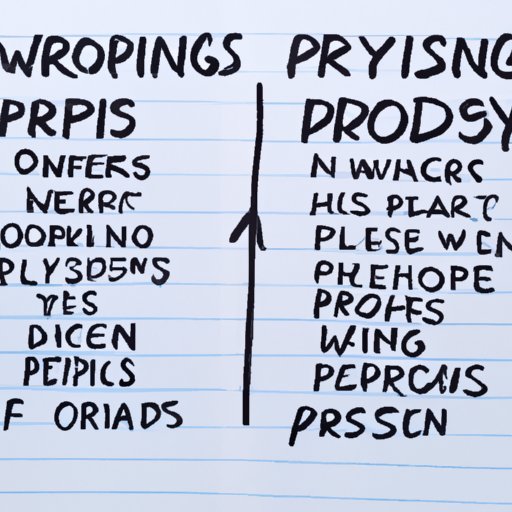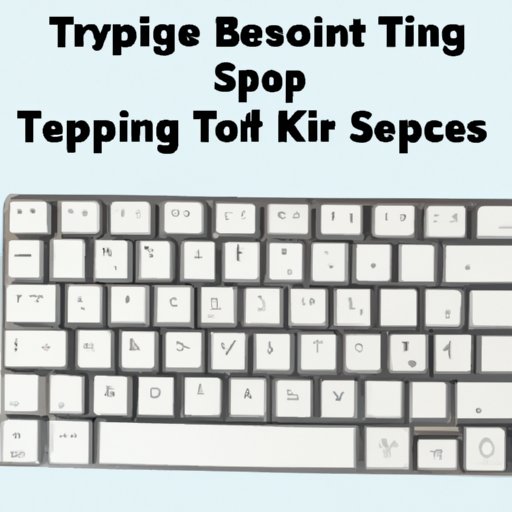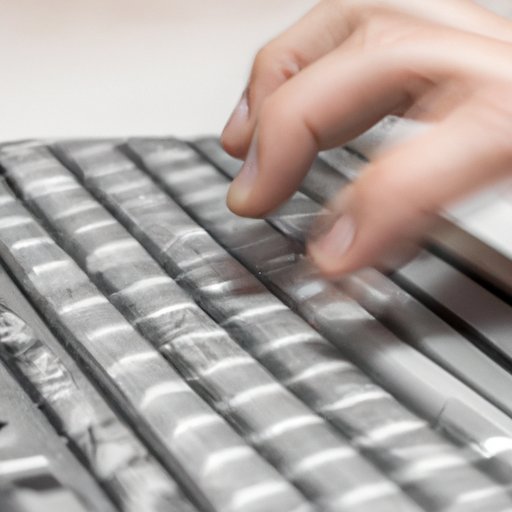Introduction
Typing and writing by hand are two methods of recording information that have been around for centuries. While the traditional method of handwriting has its benefits, modern technology has allowed us to type faster and more accurately than ever before. In this article, we will explore the pros and cons of typing versus writing by hand, as well as how technology is changing the way we write.

Pros of Typing vs Writing by Hand
Typing offers several advantages over handwriting, including increased speed, increased accuracy, easier editing, and improved legibility. Typing can also be a time-saver when it comes to taking notes or completing assignments. Here are some of the key benefits of typing versus writing by hand:
- Increased Speed: Typing is significantly faster than writing by hand, allowing you to quickly capture your thoughts and ideas without having to worry about the speed of your handwriting. This can be particularly beneficial for students who need to take notes in class or complete written assignments.
- Increased Accuracy: Typing is much more accurate than handwriting, which can help reduce errors and typos. This can be especially helpful when working with long documents or large amounts of data.
- Easier to Edit: Typing allows for easier editing and revision of written work. With typing, you can quickly make changes and corrections to your work without having to rewrite entire sections or paragraphs.
- Improved Legibility: Typing generally produces documents that are easier to read and understand than handwritten documents. This can be especially beneficial when working with colleagues or clients who may not be able to decipher your handwriting.
Cons of Typing vs Writing by Hand
Although typing offers many advantages over handwriting, there are also some potential drawbacks. These include a loss of creativity, limited accessibility, and a lack of focus. Here are some of the key drawbacks of typing versus writing by hand:
- Loss of Creativity: Writing by hand can be a more creative process than typing. Handwriting allows for the flow of ideas and encourages the writer to think more deeply about their words. Typing, on the other hand, can be more mechanical and less creative.
- Limited Accessibility: Not everyone has access to a computer or a keyboard, which can limit the ability of some people to take advantage of the benefits of typing. For those without access to a computer or a keyboard, handwriting may be the only option.
- Lack of Focus: Typing can be a distraction-filled activity, as it’s easy to get lost in the process of typing or become distracted by other tasks. Writing by hand can be a more focused activity, as it requires more of the writer’s attention.

How to Improve Your Typing Speed
If you want to improve your typing speed and accuracy, there are several techniques you can try. Practice makes perfect, so the more you type, the better you’ll become. Here are some tips for improving your typing speed:
- Practice Makes Perfect: The more you practice, the better you’ll become at typing. Take the time to practice your typing skills and you’ll soon see an improvement in your speed and accuracy.
- Try Different Keyboard Layouts: Different keyboards have different layouts, so it’s important to find one that works best for you. Try out different keyboards and find the one that feels most comfortable and natural to you.
- Use Online Tools and Resources: There are lots of online tools and resources that can help you improve your typing speed. From typing games to typing tutorials, these resources can help you hone your skills and become a faster typist.

The Benefits of Typing for Students
Typing can be a great tool for students, as it can help improve their note taking skills, speed up their research, and give them more time for reflection. Here are some of the key benefits of typing for students:
- Improved Note Taking Skills: Typing allows students to take notes quickly and accurately, which can make it easier to keep up with lectures and discussions. Typing also allows students to easily organize their notes and make revisions or additions.
- Faster Research: Typing can help students quickly search for and compile relevant information for their research projects. Typing also makes it easier to share information with others, such as classmates or teachers.
- More Time for Reflection: Typing can save time, allowing students to spend more time reflecting on their notes and thinking critically about what they’ve learned. This can help them gain a deeper understanding of the material and draw connections between concepts.
How Technology is Changing the Way We Write
Technology has had a profound impact on the way we write. Automation of processes, increased access to information, and improved collaboration are just some of the ways technology is transforming the way we write. Here are some of the key ways technology is changing the way we write:
- Automation of Processes: Technology has made it easier to automate certain writing processes, such as spell checking and grammar checking. This can help writers produce more accurate and error-free documents.
- Increased Access to Information: Technology has made it easier to access information from all over the world. Writers now have instant access to a wealth of knowledge, which can help inform and enrich their writing.
- Improved Collaboration: Technology has made it easier for writers to collaborate with each other, whether they’re in the same room or halfway around the world. This can help writers create more powerful and engaging pieces of writing.

Exploring the Impact of Typing on Creativity
As technology continues to evolve, it’s important to consider the impact of typing on creativity. While typing can certainly be a useful tool, it’s important to remember that it’s not a replacement for creative writing. Here are some of the key points to consider when exploring the impact of typing on creativity:
- Need for Reflection: Typing can be a fast-paced activity, which can make it difficult to pause and reflect on your work. It’s important to take the time to step back and consider your work from a more creative perspective.
- Impact of Digital Writing Tools: Digital writing tools, such as spell checkers and grammar checkers, can be helpful, but they can also stifle creativity. It’s important to be aware of how these tools may be impacting your writing.
- Reassessing Creative Writing Techniques: As technology advances, it’s important to reassess the creative writing techniques that have been used for centuries. While typing can be a useful tool, it’s important to remember the power of handwriting and other traditional writing techniques.
The Future of Typing: Emerging Technologies
As technology continues to evolve, new technologies are emerging that could further revolutionize the way we type. Voice to text, augmented reality, and artificial intelligence are just some of the emerging technologies that could change the way we type. Here are some of the key emerging technologies that could shape the future of typing:
- Voice to Text: Voice to text technology uses voice recognition software to convert spoken words into text. This could make it easier for people to type quickly and accurately without having to use a keyboard.
- Augmented Reality: Augmented reality (AR) technology could be used to create virtual keyboards that overlay on top of physical surfaces. This could make it easier to type in difficult or awkward situations, such as on the go or in tight spaces.
- Artificial Intelligence: Artificial intelligence (AI) could be used to create smarter keyboards that can predict words and phrases based on the context of the text. This could make it easier to type quickly and accurately without having to manually enter each letter or word.
Exploring the Different Styles of Typing for Different Purposes
Different typing styles are suited to different tasks. Touch typing, hunt and peck, and two-handed typing are just some of the common typing styles. Here are some of the key points to consider when exploring the different styles of typing for different purposes:
- Touch Typing: Touch typing is a style of typing where the fingers move quickly and effortlessly across the keyboard without looking at the keys. This is the most common style of typing and is suitable for most tasks.
- Hunt and Peck: Hunt and peck is a style of typing where the fingers hunt for the correct keys and then peck at them. This style of typing is slower than touch typing but can be useful for certain tasks, such as entering long strings of numbers or symbols.
- Two-Handed Typing: Two-handed typing is a style of typing where the left and right hands take turns typing. This can be a useful technique for increasing speed and accuracy, but it takes practice to master.
Conclusion
In conclusion, typing and writing by hand both offer their own advantages and disadvantages. Typing can be faster and more accurate than handwriting, but it can also be less creative and more distracting. Technology has had a significant impact on the way we write, and new technologies are emerging that could further revolutionize the way we type. Finally, it’s important to consider the different styles of typing for different purposes, as each style has its own advantages and disadvantages.
(Note: Is this article not meeting your expectations? Do you have knowledge or insights to share? Unlock new opportunities and expand your reach by joining our authors team. Click Registration to join us and share your expertise with our readers.)
